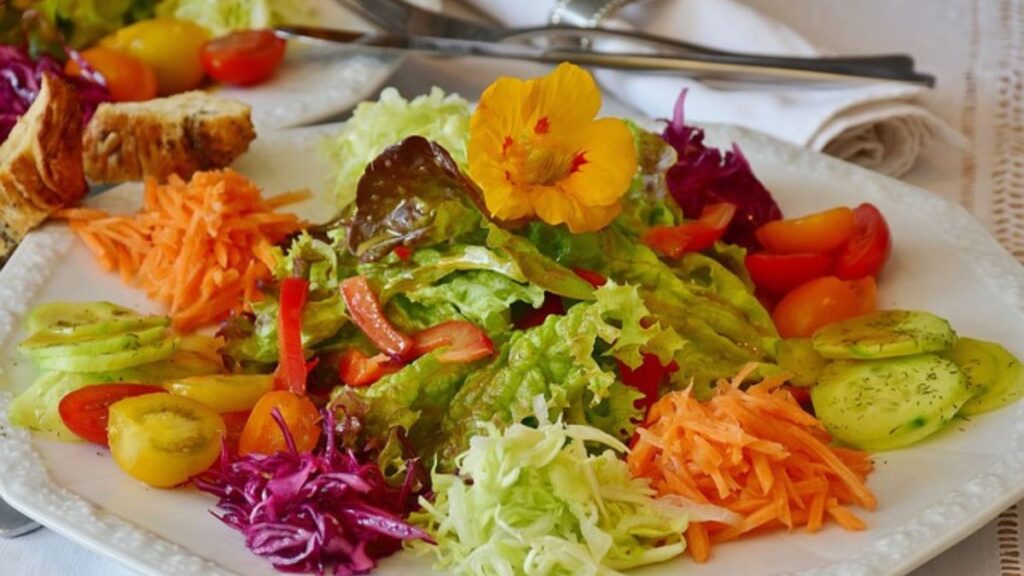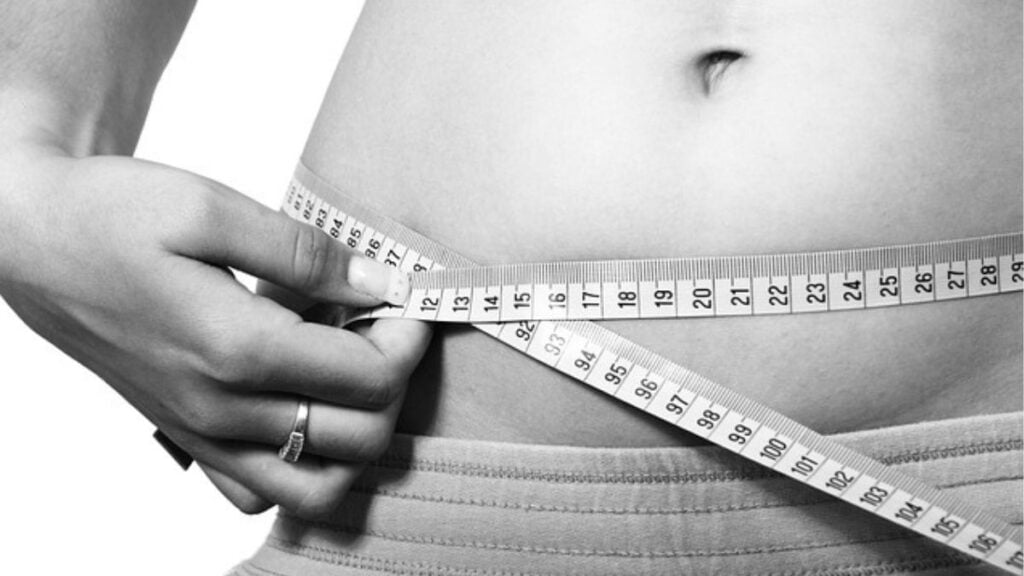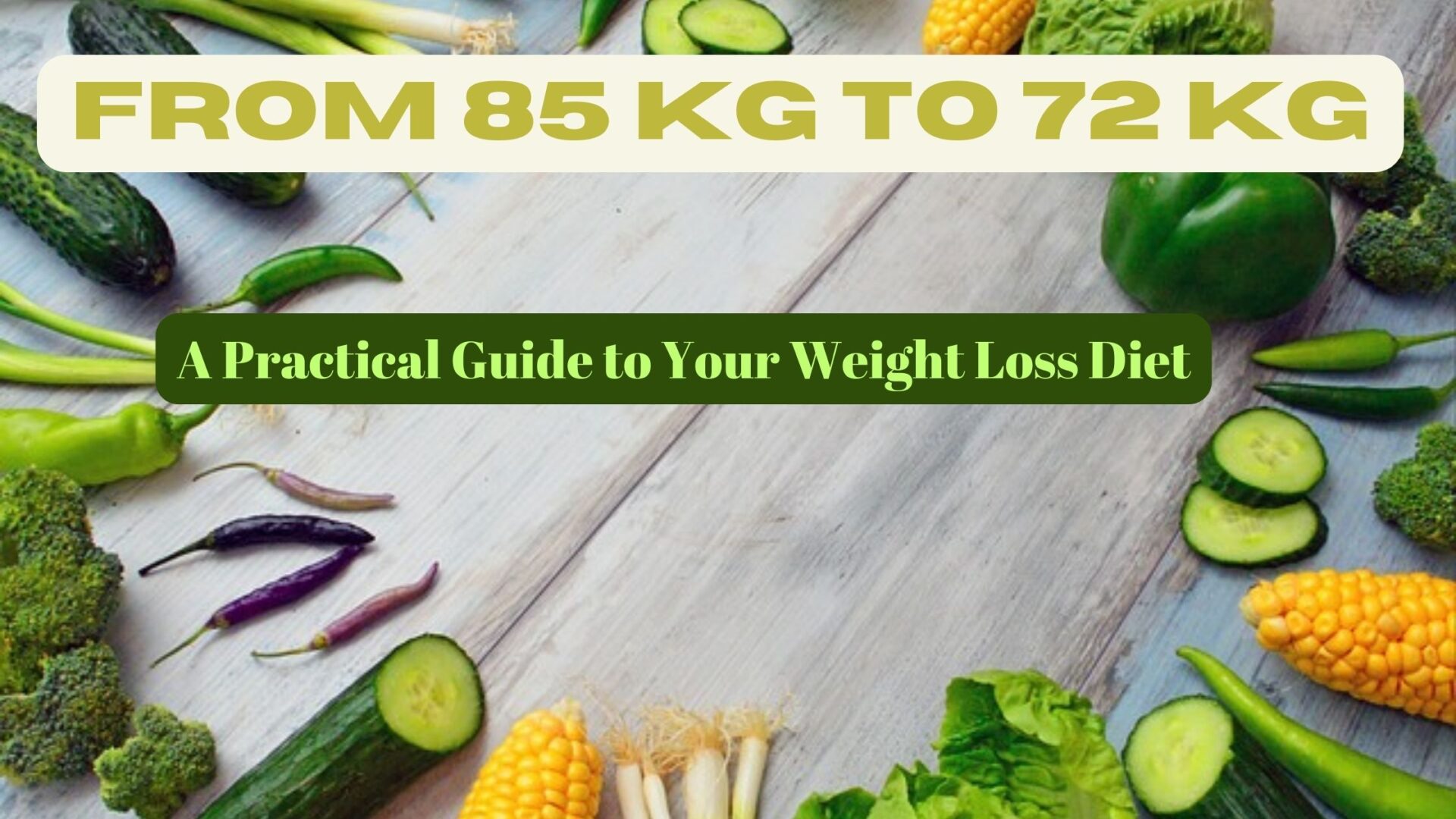Introduction:
From 85 kg to 72 kg: A Practical Guide to Your Weight Loss Diet

Embarking on a journey to transform your weight from 85 kg to 72 kg requires a practical and sustainable approach to your diet. In this comprehensive guide, we’ll explore actionable steps and expert tips to help you navigate the path to a healthier you.
From 85 kg to 72 kg: A Practical Guide to Your Weight Loss Diet
- Set Clear Goals: Defining Your Weight Loss Objectives Before diving into your weight loss diet, establish clear and realistic goals. Whether it’s a target date or specific milestones, having a roadmap will keep you motivated and focused on your journey.
- Understand Your Caloric Needs: Crafting a Personalized Diet Plan Learn about your daily caloric requirements based on factors like age, gender, and activity level. Tailor your diet plan to create a caloric deficit, a key factor in shedding excess weight.
- Prioritize Nutrient-Dense Foods: Fueling Your Body for Success Focus on nutrient-dense foods that provide essential vitamins and minerals. Incorporate a variety of fruits, vegetables, lean proteins, and whole grains to ensure a well-rounded and satisfying diet.
- Portion Control: Key to Managing Caloric Intake Master the art of portion control to prevent overeating. Understanding proper serving sizes helps you enjoy your favorite foods in moderation while staying within your caloric limits.
- Stay Hydrated: The Weight Loss Benefits of Water Explore the weight loss benefits of staying hydrated. Water not only supports metabolism but also helps control hunger, making it a crucial component of your journey from 85 kg to 72 kg.
- Mindful Eating: Cultivating Awareness for Lasting Results Adopt mindful eating practices to savor and appreciate your meals. Slow down, listen to your body’s hunger and fullness cues, and develop a healthier relationship with food.
- Incorporate Lean Proteins: Building Blocks for Weight Loss Integrate lean proteins into your diet to promote muscle maintenance and fat loss. Options like poultry, fish, tofu, and legumes provide essential nutrients while supporting your weight loss goals.
- Plan and Prep: Streamlining Your Weight Loss Journey Discover the power of meal planning and preparation. Designing your meals in advance helps you make healthier choices, saves time, and reduces the likelihood of resorting to convenient yet unhealthy options.
- Integrate Physical Activity: Enhancing Your Weight Loss Diet Combine your diet plan with regular physical activity. Whether it’s brisk walks, workouts, or sports, exercise complements your dietary efforts, accelerates weight loss, and boosts overall well-being.
- Track Your Progress: Celebrating Milestones Along the Way Monitor your weight loss journey by tracking your progress regularly. Celebrate small victories, learn from challenges, and adjust your plan as needed to stay on course from 85 kg to your target weight of 72 kg.
I am a non-vegetarian and want to reduce my weight from 85 kg to 72 kg. Can you suggest any strict diet plan?
Before embarking on any strict diet plan, it’s important to note that extreme diets may not be sustainable in the long term and can have negative effects on your health. Instead, consider adopting a balanced and sustainable approach that includes a variety of foods and meets your nutritional needs. Here’s a sample diet plan to help you reduce your weight from 85 kg to 72 kg:

Day 1:
Breakfast:
- Scrambled eggs with spinach and tomatoes
- Whole-grain toast
- Fresh fruit (e.g., berries or an apple)
Lunch:
- Grilled chicken breast
- Quinoa or brown rice
- Steamed broccoli and carrots
Snack:
- Greek yogurt with a handful of almonds
Dinner:
- Baked fish (such as salmon or cod)
- Mixed green salad with olive oil and vinegar dressing
- Sweet potato wedges
Day 2:
Breakfast:
- Oatmeal with sliced bananas and a teaspoon of honey
- Low-fat milk or almond milk
Lunch:
- Turkey or chicken wrap with whole-grain tortilla
- Mixed greens with cherry tomatoes and cucumbers
Snack:
- Cottage cheese with pineapple chunks
Dinner:
- Lean beef stir-fry with a variety of colorful vegetables (bell peppers, broccoli, snap peas)
- Quinoa or cauliflower rice
Day 3:
- Whole-grain pancakes with a dollop of Greek yogurt and berries
Lunch:
- Shrimp or prawn salad with avocado, mixed greens, and a light vinaigrette dressing
Snack:
- Sliced cucumber and carrot sticks with hummus
Dinner:
- Grilled chicken or turkey burger with lettuce, tomato, and whole-grain bun
- Steamed asparagus or green beans
General Tips:
- Stay Hydrated: Drink plenty of water throughout the day to stay hydrated and help control hunger.
- Portion Control: Be mindful of portion sizes to avoid overeating. Use smaller plates to help with portion control.
- Limit Processed Foods: Minimize the intake of processed and sugary foods, including sodas, candies, and baked goods.
- Healthy Snacking: Choose healthy snacks like fruits, nuts, or yogurt to curb hunger between meals.
- Regular Exercise: Incorporate regular physical activity, including a mix of cardiovascular exercises and strength training, to support your weight loss goals.
- Consult a Professional: Before making significant changes to your diet, consider consulting with a healthcare professional or a registered dietitian to ensure that the plan aligns with your individual health needs.
Remember, weight loss is a gradual process, and adopting sustainable habits is key to long-term success. Adjust the plan based on your preferences and consult with a healthcare professional for personalized guidance.
I want to reduce my weight from 85 kg to 72 kg. Suggest any strict exercise plan?
Before beginning any exercise plan, it’s crucial to consult with a healthcare professional or fitness expert, especially if you have any pre-existing health conditions. Additionally, a well-rounded approach that includes both cardiovascular exercises and strength training is generally recommended for effective and sustainable weight loss. Here’s a sample strict exercise plan to help you move toward your weight loss goal:

Week 1-2: Establishing the Routine
Day 1: Cardiovascular Exercise
- 30 minutes of brisk walking or jogging
- 15 minutes of high-intensity interval training (HIIT) involving sprints or cycling
Day 2: Strength Training
- Full-body workout with compound exercises (squats, deadlifts, bench press)
- 15 minutes of moderate-intensity cardio (cycling or brisk walking)
Day 3: Rest or Light Activity
Day 4: Cardiovascular Exercise
- 45 minutes of steady-state cardio (running, cycling, or swimming)
Day 5: Strength Training
- Targeted muscle group workout (focus on arms and core)
- 15 minutes of moderate-intensity cardio
Day 6: Cardiovascular Exercise
- 30 minutes of steady-state cardio
- 15 minutes of HIIT
Day 7: Active Recovery
- Light activities such as walking, yoga, or stretching
Week 3-4: Intensifying the Workouts
Day 1: Cardiovascular Exercise
- 40 minutes of running or cycling
- 20 minutes of HIIT
Day 2: Strength Training
- Full-body workout with increased resistance
- 20 minutes of moderate-intensity cardio
Day 3: Rest or Light Activity
Day 4: Cardiovascular Exercise
- 50 minutes of steady-state cardio
Day 5: Strength Training
- Targeted muscle group workout with increased intensity
- 20 minutes of moderate-intensity cardio
Day 6: Cardiovascular Exercise
- 40 minutes of steady-state cardio
- 20 minutes of HIIT
Day 7: Active Recovery
- Gentle activities to promote recovery
Week 5-8: Fine-Tuning and Adding Variety
Day 1: Cardiovascular Exercise
- 45 minutes of running, cycling, or rowing
- 20 minutes of HIIT
Day 2: Strength Training
- Full-body workout with advanced exercises
- 20 minutes of moderate-intensity cardio
Day 3: Rest or Light Activity
Day 4: Cardiovascular Exercise
- 60 minutes of steady-state cardio
Day 5: Strength Training
- Targeted muscle group workout with increased resistance
- 20 minutes of moderate-intensity cardio
Day 6: Cardiovascular Exercise
- 45 minutes of steady-state cardio
- 20 minutes of HIIT
Day 7: Active Recovery
- Incorporate yoga or flexibility exercises
Tips for Success:
- Consistency is Key: Stick to the plan consistently for the best results.
- Progressive Overload: Gradually increase the intensity and duration of your workouts as your fitness improves.
- Listen to Your Body: Pay attention to signs of fatigue or injury. Modify the plan if needed.
- Include Flexibility Training: Incorporate stretching and flexibility exercises to improve mobility.
- Stay Hydrated and Eat Well: Support your workouts with proper hydration and a balanced diet.
Remember, the key to successful weight loss is a combination of regular exercise, a balanced diet, and sustainable lifestyle changes. Adjust the plan based on your fitness level and preferences, and consult with a fitness professional for personalized guidance.
Conclusion:
Embarking on a weight loss diet from 85 kg to 72 kg is a transformative journey that requires commitment and consistency. By following this practical guide, you’ll be equipped with the tools and knowledge to make informed choices, cultivate healthier habits, and achieve lasting success on your path to a healthier weight.
FAQs:
1. How do I start my weight loss journey?
- Begin by setting realistic goals, creating a balanced meal plan, and incorporating regular exercise into your routine. Consult with a healthcare professional for personalized advice.
2. What are some effective weight loss strategies?
- Focus on portion control, eat nutrient-dense foods, stay hydrated, prioritize protein, and limit processed foods and sugary drinks. Additionally, keep track of your progress and make adjustments as needed.
3. Can I lose weight without exercise?
- While diet plays a significant role in weight loss, incorporating exercise can accelerate results, improve overall health, and boost metabolism. Even simple activities like walking can make a difference.
4. How do I overcome weight loss plateaus?
- Plateaus are common during weight loss journeys. To overcome them, reassess your diet and exercise routine, try new activities, increase intensity or duration of workouts, and focus on non-scale victories like improved energy levels or clothing fit.
5. Is it okay to indulge occasionally during a weight loss diet?
- Occasional indulgences are normal and can help maintain long-term adherence to a diet. However, practice moderation and balance by compensating with healthier choices and adjusting your calorie intake accordingly.
References:
- National Institute of Diabetes and Digestive and Kidney Diseases. “Choosing a Safe and Successful Weight-Loss Program.” https://www.niddk.nih.gov/health-information/weight-management/choosing-a-safe-successful-weight-loss-program
- Mayo Clinic. “Weight Loss: 6 Strategies for Success.” https://www.mayoclinic.org/healthy-lifestyle/weight-loss/in-depth/weight-loss/art-20047752
- Centers for Disease Control and Prevention. “Losing Weight.” https://www.cdc.gov/healthyweight/losing_weight/index.html
- American Heart Association. “Losing Weight.” https://www.heart.org/en/healthy-living/healthy-eating/losing-weight
- Harvard T.H. Chan School of Public Health. “The Nutrition Source – Healthy Weight.” https://www.hsph.harvard.edu/nutritionsource/healthy-weight/








